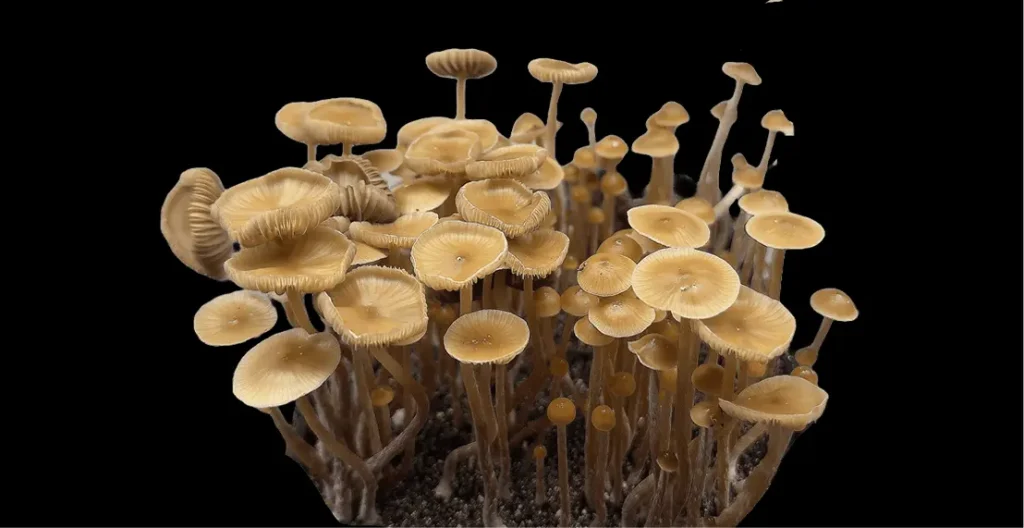🍄 Quick Learn Summary
Time to Read: 7 minutes
What You'll Learn: Key differences between Golden Teacher and B+ strains through microscopic analysis, including spore morphology, historical backgrounds, and research characteristics that distinguish these popular Psilocybe cubensis varieties.
Key Takeaway: While both strains share similar spore dimensions (11-14 μm), Golden Teacher spores often display more consistent ellipsoid shapes, while B+ spores show greater morphological variation under microscopic examination.
🏅 Golden Teacher Heritage
First documented in the 1980s, Golden Teacher emerged as a stable strain known for its distinctive golden caps and consistent spore production. The strain's name reflects both its appearance and its role as an "educational" specimen for beginning mycologists.
Geographic Origin: Likely Florida, United States
Notable Features: Consistent spore prints, reliable research characteristics
🔬 B+ Development
Developed in the 1990s through selective breeding, B+ (B-Plus) was created by mycologist Mr. G as a robust, easy-to-study strain. The "B+" designation reflects its enhanced characteristics compared to earlier B-strain varieties.
Geographic Origin: Florida, United States (cultivated development)
Notable Features: Large spore production, variable morphology
🔍 Spore Morphology Under 1000x Magnification
🎯 Key Distinguishing Features
Shape Consistency: Golden Teacher: 85-90% ellipsoid uniformity B+: 70-80% ellipsoid, with notable subglobose variants Size Distribution: Golden Teacher: Narrow size range, predictable dimensions B+: Broader size range, more variation in individual specimens Spore Wall Thickness: Golden Teacher: Consistent medium thickness B+: Slightly variable, some specimens with thicker walls Clustering Patterns: Golden Teacher: Individual spores with minimal clumping B+: Occasional small cluster formationsGolden Teacher Print Analysis
Color: Deep purple-brown to black
Density: Heavy, consistent coverage
Pattern: Even distribution with minimal gaps
Texture: Fine, powdery consistency
Storage Stability: Excellent long-term viability
B+ Print Analysis
Color: Purple-brown with slight color variation
Density: Very heavy, abundant spore production
Pattern: Dense with occasional clustering
Texture: Slightly coarser than Golden Teacher
Storage Stability: Good viability with proper storage
📊 Comparative Research Benefits
Golden Teacher Research Applications: Standardized morphology studies Reference specimens for species identification Educational microscopy demonstrations Baseline comparisons for strain development B+ Research Applications: Genetic variation studies Morphological plasticity research Hybrid development programs Environmental adaptation studies🧪 Sample Preparation Guidelines
For Golden Teacher Specimens: Standard water mount preparation 10-15 spores per slide for representative sampling 400x-1000x magnification for detailed analysis Consistent lighting for accurate color assessment For B+ Specimens: Larger sample sizes (20-25 spores) due to variation Multiple slide preparations from different print areas Document morphological variants encountered Phase contrast helpful for wall thickness analysis❌ Frequent Misidentification Issues
Problem: Confusing young B+ spores with other Psilocybe species due to size variation
❌ Overreliance on Size Measurements
Problem: Using only dimensional data to distinguish between strains
🔬 Enhanced Observation Methods
Phase Contrast Microscopy: Reveals subtle wall thickness differences Enhances internal structure visibility Particularly useful for B+ variant analysis Oil Immersion at 1000x: Provides maximum detail resolution Essential for germ pore detailed analysis Reveals surface ornamentation details Digital Documentation: Capture representative specimens from each strain Create comparison image libraries Document morphological variations over time🎯 Selecting Quality Specimens
When obtaining specimens for comparative research, ensure samples come from reliable sources that maintain proper storage conditions and provide detailed provenance information. Atlas Spores offers research-grade samples of both Golden Teacher and B+ strains with documented characteristics and verified genetics.
Quality Indicators:
- Clean, contamination-free spore prints
- Consistent color and density
- Proper storage and handling documentation
- Strain verification through morphological analysis
🤔 Frequently Asked Questions
🔬 Ready to Start Your Comparative Research?
Obtain research-grade Golden Teacher and B+ spore samples from Atlas Spores to conduct your own microscopic analysis. Our samples are prepared under laboratory conditions with verified strain characteristics for reliable research results.
Educational Disclaimer: This content is provided for educational and research purposes only. All spore samples mentioned are intended exclusively for microscopic observation and educational study. This information is not intended for cultivation purposes.

